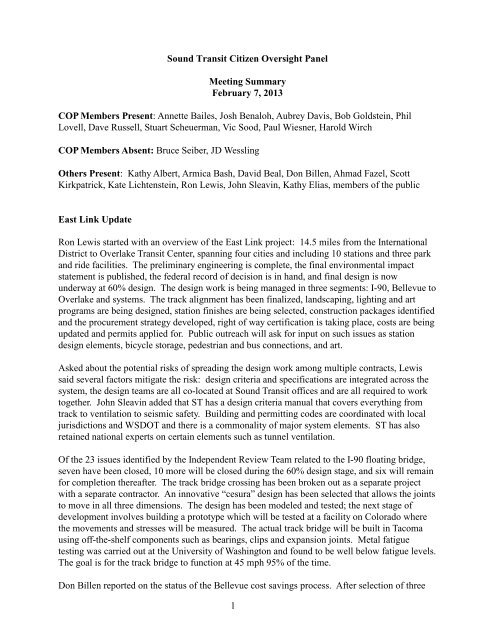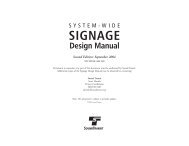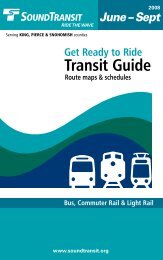1 Sound Transit Citizen Oversight Panel Meeting Summary February ...
1 Sound Transit Citizen Oversight Panel Meeting Summary February ...
1 Sound Transit Citizen Oversight Panel Meeting Summary February ...
Create successful ePaper yourself
Turn your PDF publications into a flip-book with our unique Google optimized e-Paper software.
<strong>Sound</strong> <strong>Transit</strong> <strong>Citizen</strong> <strong>Oversight</strong> <strong>Panel</strong><br />
<strong>Meeting</strong> <strong>Summary</strong><br />
<strong>February</strong> 7, 2013<br />
COP Members Present: Annette Bailes, Josh Benaloh, Aubrey Davis, Bob Goldstein, Phil<br />
Lovell, Dave Russell, Stuart Scheuerman, Vic Sood, Paul Wiesner, Harold Wirch<br />
COP Members Absent: Bruce Seiber, JD Wessling<br />
Others Present: Kathy Albert, Armica Bash, David Beal, Don Billen, Ahmad Fazel, Scott<br />
Kirkpatrick, Kate Lichtenstein, Ron Lewis, John Sleavin, Kathy Elias, members of the public<br />
East Link Update<br />
Ron Lewis started with an overview of the East Link project: 14.5 miles from the International<br />
District to Overlake <strong>Transit</strong> Center, spanning four cities and including 10 stations and three park<br />
and ride facilities. The preliminary engineering is complete, the final environmental impact<br />
statement is published, the federal record of decision is in hand, and final design is now<br />
underway at 60% design. The design work is being managed in three segments: I-90, Bellevue to<br />
Overlake and systems. The track alignment has been finalized, landscaping, lighting and art<br />
programs are being designed, station finishes are being selected, construction packages identified<br />
and the procurement strategy developed, right of way certification is taking place, costs are being<br />
updated and permits applied for. Public outreach will ask for input on such issues as station<br />
design elements, bicycle storage, pedestrian and bus connections, and art.<br />
Asked about the potential risks of spreading the design work among multiple contracts, Lewis<br />
said several factors mitigate the risk: design criteria and specifications are integrated across the<br />
system, the design teams are all co-located at <strong>Sound</strong> <strong>Transit</strong> offices and are all required to work<br />
together. John Sleavin added that ST has a design criteria manual that covers everything from<br />
track to ventilation to seismic safety. Building and permitting codes are coordinated with local<br />
jurisdictions and WSDOT and there is a commonality of major system elements. ST has also<br />
retained national experts on certain elements such as tunnel ventilation.<br />
Of the 23 issues identified by the Independent Review Team related to the I-90 floating bridge,<br />
seven have been closed, 10 more will be closed during the 60% design stage, and six will remain<br />
for completion thereafter. The track bridge crossing has been broken out as a separate project<br />
with a separate contractor. An innovative “cesura” design has been selected that allows the joints<br />
to move in all three dimensions. The design has been modeled and tested; the next stage of<br />
development involves building a prototype which will be tested at a facility on Colorado where<br />
the movements and stresses will be measured. The actual track bridge will be built in Tacoma<br />
using off-the-shelf components such as bearings, clips and expansion joints. Metal fatigue<br />
testing was carried out at the University of Washington and found to be well below fatigue levels.<br />
The goal is for the track bridge to function at 45 mph 95% of the time.<br />
Don Billen reported on the status of the Bellevue cost savings process. After selection of three<br />
1
cost savings modifications by the Board last October, a SEPA addendum is being prepared and<br />
will be published in March, with decisions by the ST Board and the City anticipated in April. All<br />
three ideas involve getting the alignment out of the ground so are very likely to yield real savings.<br />
The construction delivery plan for the Bellevue to Overlake segment has been identified and the<br />
I-90 segment and systems plans are in development. The Bellevue to Overlake segment is<br />
proposed to be divided into four contracts: South Bellevue as design-bid-build; Downtown as<br />
GC/CM; Bel-Red as GC/CM; and SR 520 as design-build. The factors influencing the choice are<br />
the complexity of the segment and whether it is at-grade, elevated or in a tunnel. Asked whether<br />
any joint development is anticipated, Lewis said ST is pursuing a public-private partnership at<br />
the 120 th Street Station; also a pedestrian bridge at Overlake <strong>Transit</strong> Center is being considered,<br />
with funding from the City of Redmond.<br />
The schedule has the project baselined in the spring of 2014 and construction starting 2015. The<br />
final design stage budget is $757 million, with $200 M committed. The estimated final cost is<br />
trending on budget. Challenges include the financial impacts of the recession on revenues; timely<br />
decision making by the City of Bellevue on code amendments, cost savings options and technical<br />
solutions; maintaining the final design schedule; 3 rd party coordination; and upward cost<br />
pressures on the project. Asked what would happen if the park and ride capacity fills up, Billen<br />
said it will fill up. Height limits preclude the parking structures going higher. Local transit will<br />
have to maximize feeder service to the stations. Asked how the project is using the lessons<br />
learned from the other Link segments, Lewis said he is in frequent contact with Joe Gildner and<br />
Don Davis and is focused on a high degree of systems coordination.<br />
<strong>Transit</strong>-Oriented Development<br />
David Beal introduced the presentation, saying that TOD has been busy the past year, especially<br />
with the newly developed TOD policy and the Capitol Hill TOD term sheet developed with the<br />
City and the community. Kate Lichtenstein described the Board direction leading to the new<br />
policy: consolidate and update the existing TOD policies in one document; maintain the transit<br />
mission; encourage TOD to increase ridership; emphasize coordination and partnerships; assess<br />
TOD early in system and project planning; and involve the Board and stakeholders. After<br />
reviewing other agencies’ policies and meeting with over 20 stakeholder groups, staff brought a<br />
draft policy to the Board in October. In December the final policy was adopted.<br />
The policy framework established a goal to focus growth around transit facilities and leverage<br />
transit investments to help produce regional and local benefits. Other goals include increasing<br />
ridership, supporting plans, economic development, and protecting and enhancing assets. The<br />
strategies involve the dual goal of both agency TOD and community TOD where the local<br />
jurisdiction leads the process. A key provision is allowing early TOD assessment during<br />
development of plans and projects, and coordinating with the Phase Gate process.<br />
Scott Kirkpatrick said that ST can now do station-area planning and can do more to participate in<br />
and support community planning. Asked what remedies <strong>Sound</strong> <strong>Transit</strong> has available if a<br />
developer wanted to build a widget factory on a TOD site, Kirkpatrick stated that ST issues RFPs<br />
with strong covenants and encumbrances that specify the type of development being sought. The<br />
proposer must sign and be bound by the covenants. ST also has the ability to screen proposers<br />
2
for financial capacity and will not close a sale until all building permits are in hand.<br />
Current activities in the TOD pipeline include the Capitol Hill term sheet to develop five parcels<br />
near the Capitol Hill Station; this will be the largest-ever TOD at 500,000 square feet. The term<br />
sheet will go before the Seattle City Council in the April/May time frame. Another major TOD is<br />
the Mount Baker Lofts project which is within weeks of closing and will provide 57 units of livework<br />
space with no parking on site. The South 200 th Angle Lake site is out for early marketing to<br />
the hospitality industry to assess feasibility of a hotel. No <strong>Sound</strong> <strong>Transit</strong> TOD has gone out this<br />
early before. The Orcas/Centioli TOD on Martin Luther King Way was a proposed 70-unit<br />
project that fell through. ST is completing procurement documents for remediation on the site.<br />
On the Lynnwood extension, staff are providing technical assistance to the cities of Shoreline and<br />
Mountlake Terrace. On the East Link extension 130 th Station, staff are providing technical<br />
assistance in collaboration with the City of Bellevue.<br />
Asked what safeguards are in place to protect against potential conflicts of interest or abuse,<br />
Kirkpatrick replied that since money is involved, there is always a risk, but ST uses a fair and<br />
open process based on business decisions and fair market value. An example arose where<br />
community members wanted to be involved in selecting and negotiating with the developers and<br />
ST said No. Asked about the funding for the new TOD staff positions, Beal explained that one of<br />
the positions was transferred from planning and charged to the agency budget; the new half-time<br />
position is assigned to ST3 planning and will be charged to the projects. Other costs are borne in<br />
the <strong>Sound</strong> Move lifetime TOD planning budget of $1.64 million which in 2013 still has a balance<br />
of $495,000. A new TOD surplus property budget of $5.6 M lifetime is used to prepare property<br />
no longer needed for transit purposes; $4.4 M remains in that fund.<br />
How does ST coordinate with the PSRC’s transit-oriented planning efforts? The PSRC looked<br />
regionally at 72 intermodal station sites in a much broader way and ST was engaged in that<br />
process for its sites. A member noted that the Roosevelt community had no technical assistance<br />
in its station-area planning, either from the City or from ST. Kirkpatrick said this was a big<br />
concern for the Board and perhaps the single biggest impetus for the new policy.<br />
Discussion<br />
Members discussed the Draft COP Year-End report and made suggestions for changes:<br />
On page 2, the suggested recommendation for a one one-page, side by side comparison of<br />
budget-to-budget and forecast-to-budget percentages was good.<br />
Another useful suggestion would be to break out the current service budget plus additions<br />
due to new projects or services.<br />
COP should also encourage actual-to-actual comparisons for multiple years.<br />
The terminology of phrases like “budget,” “forecast” and “actual” can be very confusing<br />
and should be clarified.<br />
The budget-to-budget presentation is required by the state’s BARS reporting requirements<br />
but there is nothing to say that ST cannot provide additional formats. Local jurisdictions<br />
generally do this.<br />
Management has been convincing that the agency is in fact using actual spending data<br />
3
and that it is all there.<br />
Capital budgets can be tricky and underspending in a given year is very common.<br />
On page 3, the new statement regarding Board engagement is much more constructive<br />
than the earlier draft.<br />
On page 11, the table needs an explanatory statement about the use of the term “forecast.”<br />
Should there be a sentence added in the report to say that COP is considering a task force<br />
to review multiple years of <strong>Sound</strong> <strong>Transit</strong> performance? The chair and vice chair are still<br />
considering options for the scope of such a task force and will bring back a<br />
recommendation to a future meeting.<br />
Members decided to add a sentence to the cover letter and to the body stating that COP<br />
was considering creating a task force.<br />
Kathy Elias explained that the table on page 10 showing subarea reserves may have been a<br />
miscommunication with staff. Pending a conversation with Finance, that table might be changed<br />
or deleted from the report.<br />
The report as amended was moved, seconded and approved unanimously.<br />
Members next discussed the presentation on East Link:<br />
The basic logic of which contracting model to use for each segment can be described as:<br />
design-bid-build for straightforward, low risk construction; GC/CM for more complex<br />
construction with unknowns and more value engineering needed and tighter risk<br />
management; the design-build model is also for fairly straightforward projects where a<br />
high degree of control by the owner is not needed.<br />
ST recently sent five persons to a training on GC/CM and appears to be interested in<br />
building the agency’s staff capacity to manage these types of contracts.<br />
Member Reports<br />
Dave Russell reported that he attended a forum on TOD and joint development best<br />
practices. FTA regional administrator Rick Krochalis was one of the presenters as were<br />
staff from ST, King County and Portland.<br />
Harold Wirch reported that route 511 continues to be overcrowded in the peak.<br />
Aubrey Davis reported that he attended the Mercer Island WSDOT public meeting on<br />
tolling I-90. Mercer Islanders do not want tolls.<br />
Josh Benaloh said he attended the Bellevue version of the tolling meeting where the<br />
citizens were not quite as vociferous. He also attended a meeting on the status of the SR<br />
520 bridge construction. It is not well recognized that the new bridge does not touch<br />
down on the west end with all six lanes.<br />
Next <strong>Meeting</strong><br />
The next COP meeting was set for <strong>February</strong> 21, 2013, 8:30 to 11:00 am.<br />
4






